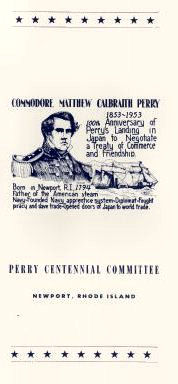![]()
Postal History Introduction
Stampless
Covers
1846
to 1900 Issues
1901-1950
Issues
1951-2003
Issues
Cancels
&
Miscellaneous
Postal
Stationery
Post
Cards
Air
Mail
First
Day &
Event Covers
Parcel Post/Special Delivery
Registered & Official Mail
Commercial & Advertising
Revenue & Postage Due
Wildlife & Game Issues
Complete List of RI Issues
|
Rhode Island
Illustrated Event Covers |
||
|
||
|
Commodore Perry joined the Navy as a midshipman in 1809 and served his first cruise aboard the USS Revenge. During the War of 1812, Perry was commissioned as a Lieutenant and served on the frigate President under Commodore John Rodgers. He married Jane Slidell, the daughter of a New York merchant in 1814. Perry was attached to the Brooklyn Navy Yard after the war and in 1819 served on board the USS Cyane during her voyage to Liberia. He served on USS Shark from 1822 to 1825. Perry served as the Fleet Captain to Commodore Rodgers in the Mediterranean during 1826 and 1827 and returned to Charleston, SC in 1828 for a tour of shore duty. |
|
|
Perry took over command of the USS Concord in 1830 and then was appointed Commandant of the Brooklyn Navy Yard. During this time he was instrumental in helping to develop the Naval Apprenticeship System. He also helped to develop the first steam warship, USS Fulton. From 1840 to 1843 Perry commanded an American Naval Squadron off the coast of Africa helping to suppress the slave trade. Perry commanded the American fleet in the Gulf of Mexico during the Mexican War. In March of 1852, President Fillmore placed Commodore Perry in charge of the expedition to induce the Japanese government to establish diplomatic relations with the United States. Commodore Perry departed Norfolk, Virginia in the fall of 1852 and on July 8, 1853 entered the harbor of Uraga, Japan with four ships. The Japanese government initially refused to meet with him and ordered him out of the country, however their defenses were inadequate to force him to leave. On July 14, 1853, after several days of sparing back and forth, the Japanese finally accepted the formal letter requesting a treaty. Perry, after promising to return the following spring then departed Japanese territorial waters. Commodore Perry returned to Japan; entering Tokyo Bay in February, 1854 with 9 ships and on March 31 the treaty between the United States and Japan was signed. Matthew Calbraith Perry died on March 4, 1858 in New York, NY. In 1866 his remains were removed from New York and interred at the Island Cemetery in Newport, Rhode Island. A statue honoring Commodore Perry was erected in Touro Park in 1868. Sources: |
||
![]()
RI Historical
Society
The Post Offices
Home Page
RI Tercentenary Issue History
RI Philatelic Society
Recently Added Pages
Philatelic Primer
Rhode Island Around the World
Rhode Island
Town Postmarks
Other Websites of Interest

